While NPOs attract regular attenders, independent theatre is more successful at broadening the theatre audience base, suggests new report.

Scott Kublin (CC BY-NC-SA 2.0)
New analysis of UK theatre ticket-buying has thrown the contrast between audiences at funded and non-funded theatre into stark relief, and revealed key differences between audiences in London and elsewhere. Those with easy access to London’s theatre scene display a more frequent and varied attendance pattern than others, demonstrating the value of a concentration of arts facilities, both funded and non-funded, on the development of a wider audience. Non-funded theatres – especially popular West End shows – are the primary entry point for many first-time theatre goers, and the independent theatre sector in London attracts a significantly more geographically-dispersed audience than London’s National Portfolio Organisations (NPOs). Whereas inner-London postcodes account for around a quarter of all revenues at NPO venues in London, they contribute only about 15% of revenues at independent venues in the capital.
By contrast, the strength of NPOs is in their ability to attract and retain regular arts attenders. Over half of ticket sales at Arts Council England’s NPOs are made to ‘regular’ and ‘very regular’ arts attenders – those who have attended at least six times in the past three years. The most regular attenders of all – those who have bought tickets at least ten times in the past three years – represent only 7.5% of all ticket buyers, but they account for over 40% of all visits to NPOs, though less than 22% of visits to independent theatres. Infrequent attenders – who have booked theatre tickets only once or twice in the past three years – make up 62% of the theatre-going public, but account for just 25% of visits to NPOs. By contrast, 40% of visits to independent theatres are made by this group. The report attributes these differences partly to different artistic programmes in the funded and non-funded sectors, but also to NPOs’ “superior potential to communicate directly” with customers. Whereas London’s independent theatres rely heavily on 3rd party resellers for their ticket sales, outside London the majority of ticket transactions are directly with consumers and agents play a far smaller role.
The figures have been compiled by data specialists Purple Seven, and summarised in the report ‘A New Perspective of Theatre Going in England’. The analysis is based on ticketing records across 110 participating venues, on 5.6m ticket buyers for 11.4m visits and 36.9m tickets worth £994m.




